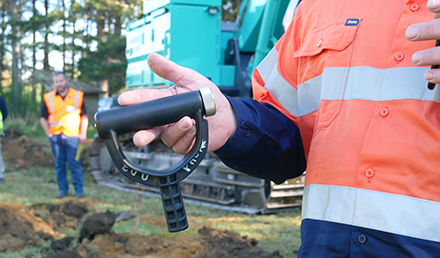A ‘smart spade’ which identifies exactly where to plant a tree seedling is just one of the new technologies in the seven-year NZ$25.5 million Precision Silviculture development project. Source: Timberbiz
The newly elected President of New Zealand’s Forest Owners Association, Grant Dodson, says the just announced joint government funded project to bring mechanisation and robots to the production of tree seedlings and the tending of plantations covers a wide range of technologies.
“It’s not a single Eureka discovery which is going to make all this work,” he said.
“It’s combining, for instance, a planter with a sensor and linking it to electronic mapping. The map sends a beep signal to the planter that they need to go a couple of metres up or along the slope to put the seedling in. The end result is a much more optimally spaced plantation forest which makes for better growth and easier and safer harvesting.”
Mr Dodson says that the growth in mechanical harvesting over the past decade already shows that using machinery results in greater productivity and a much safer workplace.
“In harvesting, we are now onto our next phase, developing robot operations, particularly for sorting and grading logs. There is great opportunity to apply these technologies to the nursery and forest growing operations.”
Mr Dodson says the Government’s Fit for a Better World roadmap for increased food and fibre exports heavily relies on forestry, to deliver an extra $2.6 billion in export revenue by 2030.
“That’s more growth than is expected out of the whole pastoral sector combined.”
National Research Manager, Paul Adams says Precision Silviculture will bring extra returns when the trees are harvested, but the increasing need for biofuels and plastic replacements are acknowledged in the project too and will help New Zealand meet its climate goals.
“The development of mechanised thinning and pruning will not only make these operations safer, more efficient and more precise, but also enable them to integrate into mechanical extraction of now increasingly valuable forest biomass,” Mr Adams says.
“Using machinery and remote sensing through our silviculture operations lets us keep very accurate records of how well the trees in the forests are doing.
“At the moment the usual way of assessing the growth and quality of a forest is through someone going in and measuring a few samples. Using technology to measure the development of each and every tree and batch of seedlings would be a quantum leap in management and ultimately much more precise breeding selection as well.”
Mr Adams also says remote sensing will enable the already small volume of herbicide use in forest nurseries to be reduced.
“And we are looking at using water retaining gels for the seedling roots, which is not practical at present.
“That could extend the planting season from four to six months and into drier areas and periods, which will occur in most regions with climate change.
The NZ Government is contributing $10.2 million to the project through the Ministry for Primary Industries’ Sustainable Food and Fibre Futures fund.






